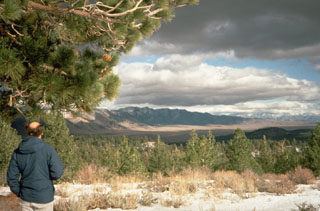Report on Long Valley (United States) — August 1982
Scientific Event Alert Network Bulletin, vol. 7, no. 8 (August 1982)
Managing Editor: Lindsay McClelland.
Long Valley (United States) Minor seismicity; deformation data summarized
Please cite this report as:
Global Volcanism Program, 1982. Report on Long Valley (United States) (McClelland, L., ed.). Scientific Event Alert Network Bulletin, 7:8. Smithsonian Institution. https://doi.org/10.5479/si.GVP.SEAN198208-323822
Long Valley
United States
37.7°N, 118.87°W; summit elev. 3390 m
All times are local (unless otherwise noted)
Seismic activity in the Long Valley area remained minor in August and early September. No spasmodic tremor was recorded, and since the six minor shocks of 13 July only occasional individual earthquakes have occurred in the epicentral area of previous swarms, on the S side of the caldera.
Francis Riley provided the following report.
"Preliminary review of spirit levels and electronic distance measurements obtained May-August 1982 in Long Valley Caldera suggests that uplift and horizontal extension in the W-central part of the caldera are continuing. Maximum values of uplift as defined by presently available data occur along the W side of the resurgent dome and amount to 33 cm since 1975. Maximum values of extensional strain since 1978 exceed 45 microstrain (change in length divided by original length x 106) and are associated with the resurgent dome and S caldera rim."
Geological Summary. The large 17 x 32 km Long Valley caldera east of the central Sierra Nevada Range formed as a result of the voluminous Bishop Tuff eruption about 760,000 years ago. Resurgent doming in the central part of the caldera occurred shortly afterwards, followed by rhyolitic eruptions from the caldera moat and the eruption of rhyodacite from outer ring fracture vents, ending about 50,000 years ago. During early resurgent doming the caldera was filled with a large lake that left strandlines on the caldera walls and the resurgent dome island; the lake eventually drained through the Owens River Gorge. The caldera remains thermally active, with many hot springs and fumaroles, and has had significant deformation, seismicity, and other unrest in recent years. The late-Pleistocene to Holocene Inyo Craters cut the NW topographic rim of the caldera, and along with Mammoth Mountain on the SW topographic rim, are west of the structural caldera and are chemically and tectonically distinct from the Long Valley magmatic system.
Information Contacts: A. Ryall, University. of Nevada, Reno; F. Riley, USGS, Denver, CO; R. Bailey, USGS, Reston, VA.

